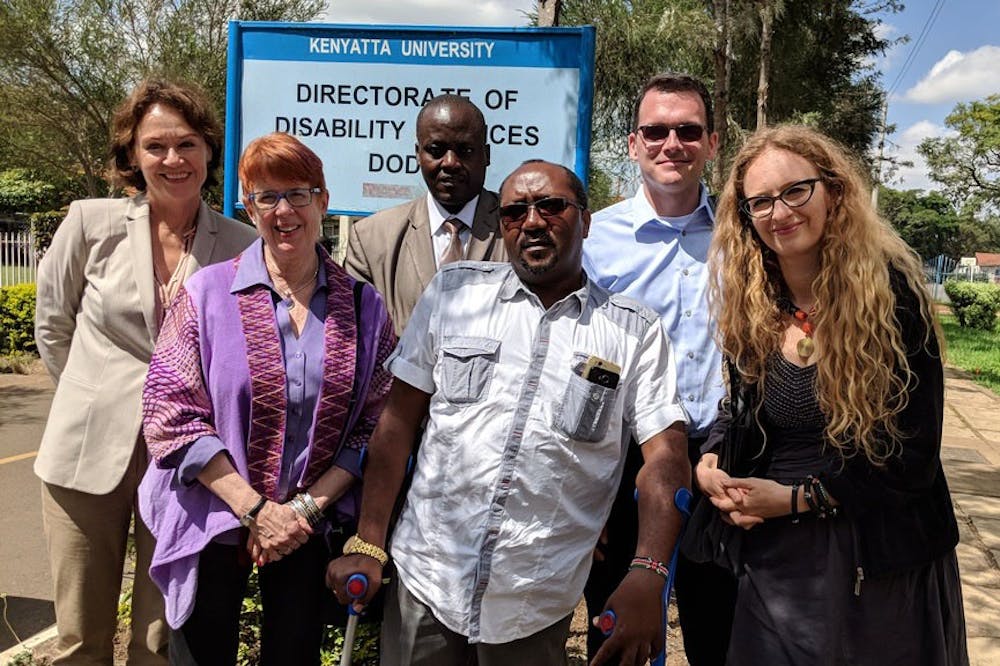ASU professors traveled to Kenya to cement a formal collaboration agreement with Kenyatta University. The two institutions hope to establish international linkage between faculty and students.
“Both institutions are eager to create educational opportunities for students and seek to foster research projects,” Nina Berman, director and professor in the School of International Letters and Cultures, said.
This signed agreement comes from the professors' first official trip to Kenya in late May. During their two-week stay, Berman, Beth Blue Swadener, a professor in the School of Social Transformation and Paul Quinn, director for American Sign Language in the Department of Speech and Hearing Science, traveled around the southwestern region of Kenya, visiting university campuses and meeting with representatives.
Though this was the team’s first sanctioned trip to Kenya, Berman and Swadener worked on individual projects in Africa in prior years. Berman, the head of the collaboration, researched tourism and worked with colleagues in the special needs programs in Kenya.
Swadener worked as an external examiner in residence at Kenyatta University. In this position, she worked with graduate students to assess master's and Ph.D programs. Aside from work at the university, Swadener is also the co-founder of the Jirani Project, a non-profit dedicated to supporting the education of Kenyan children.
During the trip, Berman, Swadener and Quinn met with representatives from seven universities. Most of the focus, however, went to Kenyatta University, Mount Kenya University and Moi University.
Kenyatta University, the first official site of collaboration, ranks second of all private and public universities in Kenya.
The three met with specific programs from each of the schools. At Kenyatta University and Mount Kenya University, Berman, Swadener and Quinn met with department heads for early childhood education and special needs education, as well as with the student disability centers.
“Typically we met with deans or chairs of programs," Swadener says. "In some cases, we met with most of the faculty of a program. We also, very importantly, met with people who are in charge of linkages and international partnerships."
Despite the focus on initial meetings, Quinn visited several schools for the deaf in the Nairobi area. During his visit, he met with students from five to 18 years old.
“It was simply amazing. When I walked in the room, they looked at me with extreme curiosity in their eyes," Quinn said. "When I lifted my hands to start signing, they just lit up with excitement. They were all pointing at me signing back, ‘you signing!’ We instantly found this common bond."
Through his experience touring multiple schools for the deaf, Quinn identified a need for speech pathology and audiology.
“Those who are born deaf (or) become deaf at a very young age that are likely best served by learning KSL (Kenyan Sign Language) as their first language. However, for the ones deafened later in life, who have already developed language and speech, there is a great need for professional intervention,” Quinn said.
“ASU has the resources and programs that could connect with universities in Kenya to promote programs like this. Both what we can provide to them and the culture and experience they can share with us could change the way we help people both in Kenya, that African region, and in the U.S.”
This partnership is relatively new. As of now, the core team is still working to determine the framework of the collaboration. Despite this, there are currently several projects in motion. The first goal is to recruit and meet with other ASU faculty who are currently involved in or have been involved with projects in Kenya or are interested in starting some kind of collaboration with Kenya.
“I’ve worked closely with one colleague in women and gender studies who’s done extensive work with Maasai school girls, and I am working with a postdoc in the Sanford School of Social and Family Dynamics," Swadener says. "Both of these colleagues did their dissertations in Kenya. I can just see that it will broaden connections like that.”
The possible areas of research collaboration are diverse. Berman has identified many areas of overlap with Kenya and Arizona.
“I think about structural similarities, such as water issues, challenges due to climate change, poverty, border security and more. In these and other areas, both Arizona and Kenya are challenged to come up with solutions in order to enable their societies to thrive,” Berman says.
Swadener and Berman hope to schedule a formal meeting within the next few weeks. Aside from outreach to other faculty, the team hopes to host a delegate of Kenyatta University colleagues in Tempe and is exploring the possibility of incorporating online education into Kenyan colleges.
Reach the reporter at kiera10riley@gmail.com or follow @kiera_riley on Twitter.
Like State Press Magazine on Facebook and follow @statepressmag on Twitter.

Kiera Riley is a managing editor at State Press Magazine. She also interns at the politics desk for the Arizona Republic




